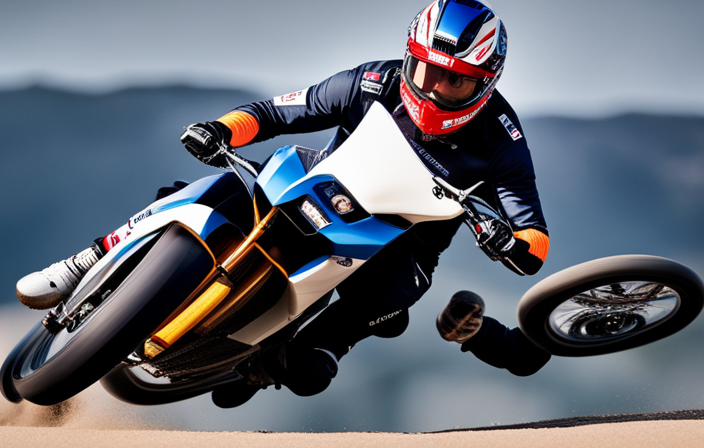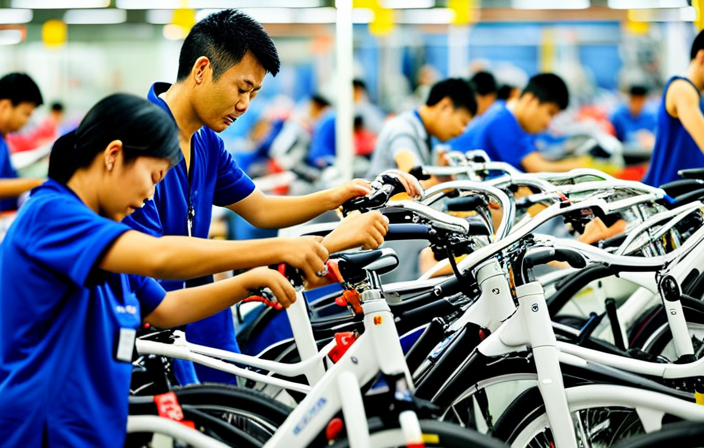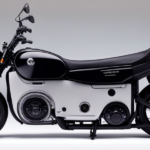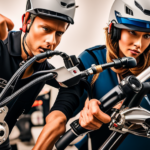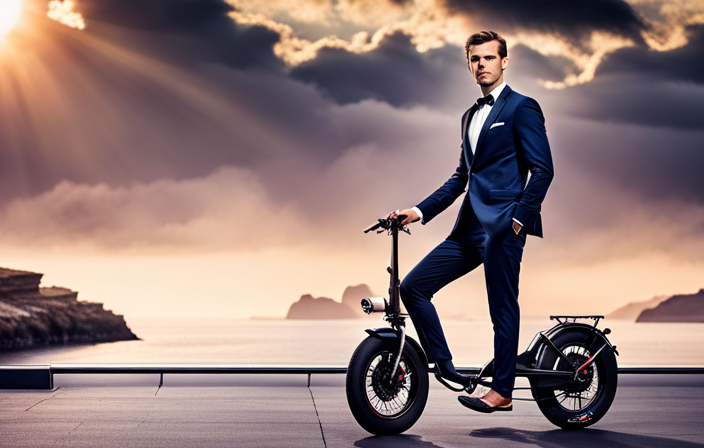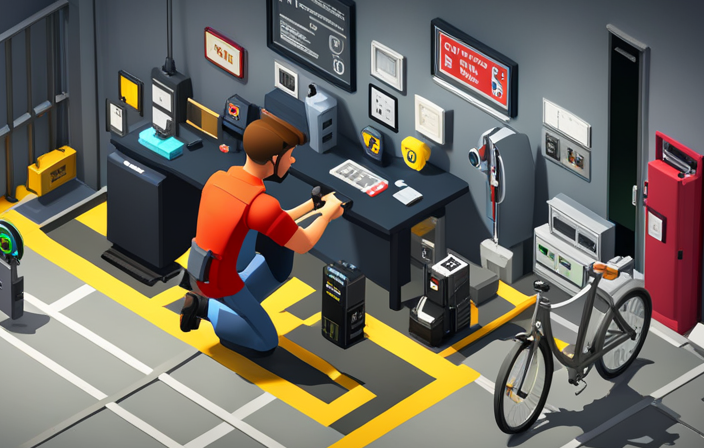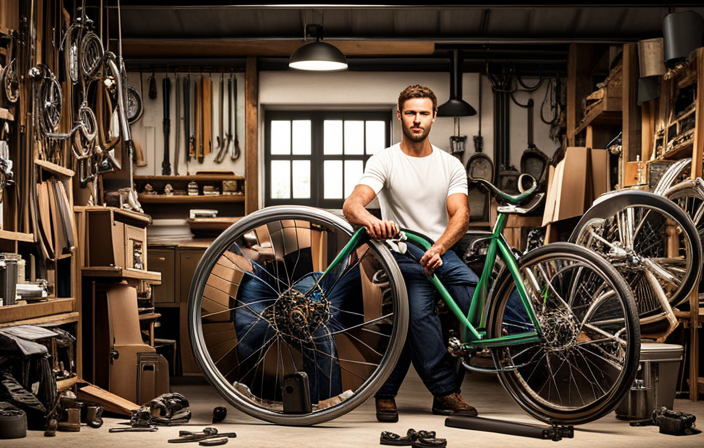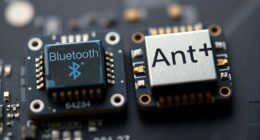I have frequently found myself in a frustrating predicament – all geared up to go for a bike ride, only to realize that the electric start is not functioning. This is a common problem that many motorcycle enthusiasts face, but fear not, I have a solution for you.
In this article, I’ll walk you through a step-by-step guide on how to start your bike when the electric start fails. From checking the battery and connections to kick-starting the bike and troubleshooting the ignition system, we’ll cover it all.
So, let’s get started and get you back on the road in no time.
Key Takeaways
- Ensure the kill switch is in the ‘ON’ position and check for loose connections or damaged wires near the kill switch.
- Engage the choke by pulling out the choke lever and clean or replace the choke mechanism if it’s not working.
- Check fuel levels before troubleshooting electrical connections and refuel if necessary.
- Inspect battery terminals for corrosion or loose connections, tighten terminals, and clean corrosion with a wire brush.
Check the Battery and Connections
First, make sure you’re wearing protective gloves and goggles.
To check the battery and connections, start by checking the battery voltage. Connect a multimeter to the battery terminals and ensure that the voltage reading is within the recommended range. If the voltage is low, you may need to charge the battery or replace it if it cannot hold a charge.
Next, clean the battery terminals to ensure a good connection. Disconnect the negative terminal first, followed by the positive terminal. Use a wire brush to remove any corrosion or dirt from the terminals. Reconnect the terminals securely.
By checking the battery voltage and cleaning the terminals, you can ensure that the electrical system is functioning properly.
Now, let’s move on to testing the starter motor.
Test the Starter Motor
To check if the starter motor is functioning, try turning the ignition key while listening for any clicking or buzzing sounds.
Here are some troubleshooting tips and common issues to consider:
-
Check the battery voltage: Use a multimeter to measure the voltage of the battery. If it’s below 12 volts, the starter motor may not have enough power to start the bike.
-
Inspect the connections: Ensure that the battery terminals and starter motor connections are clean and tight. Loose or corroded connections can cause starting issues.
-
Test the starter solenoid: Locate the solenoid and use a test light or multimeter to check if it’s receiving power when the ignition key is turned. If there’s power but no clicking sound, the solenoid may be faulty.
If the starter motor still doesn’t work after troubleshooting these common issues, you can try kick-starting the bike as an alternative method to start it.
Try Kick-starting the Bike
If the starter motor fails to function, you can attempt kick-starting the bike instead. Kick starting is a technique used to manually start a bike by forcefully kicking the kick-start lever with your foot. Here are the steps to troubleshoot kick starting:
- Ensure the bike is in neutral and the ignition is on.
- Stand on the left side of the bike and locate the kick-start lever.
- Place your left foot on the kick-start lever and firmly push it downward.
- As you push down, use your body weight to generate enough force for the kick-start lever to return to its original position.
- Repeat the process until the engine starts.
Remember, kick-starting requires practice and may not always work if there are underlying issues with the bike’s engine or fuel system. If kick-starting fails, it’s time to check the ignition system.
To transition into the subsequent section about checking the ignition system, we need to understand that troubleshooting kick-starting is just one step in the process.
Check the Ignition System
When troubleshooting the ignition system, it’s crucial to inspect the spark plug for any signs of damage or fouling.
Start by removing the spark plug from the engine using a spark plug socket and a ratchet.
Examine the electrode for any wear, cracks, or carbon buildup.
If necessary, replace the spark plug with a new one to ensure optimal performance and ignition.
Inspect the spark plug for any damage or fouling
First, check the spark plug for any signs of damage or fouling. Inspecting the spark plug is an essential step in troubleshooting starting issues with a bike. Signs of damage include cracked or broken porcelain insulator, damaged electrode, or excessive wear.
Fouling can occur due to oil or fuel deposits on the spark plug, which can prevent proper ignition. To inspect the spark plug, remove it from the engine using a spark plug socket wrench. Examine the spark plug carefully for any signs of damage or fouling.
If you notice any issues, such as a damaged electrode or excessive deposits, it may be necessary to replace the spark plug. Now, let’s move on to the next section and discuss how to replace the spark plug if necessary.
Replace the spark plug if necessary
To replace the spark plug if necessary, you’ll need a spark plug socket wrench and a new spark plug. Start by locating the spark plug on your bike’s engine. It is usually found near the top of the engine and has a rubber boot attached to it.
Use the spark plug socket wrench to remove the old spark plug by turning it counterclockwise. Inspect the spark plug for any signs of damage or fouling. If it looks worn out or covered in deposits, it’s time to replace it.
Take the new spark plug and apply a small amount of anti-seize compound to the threads. Carefully thread the new spark plug into the engine by hand, and then use the socket wrench to tighten it snugly. This will ensure a good connection and prevent the plug from loosening during use.
With the spark plug replaced, you can now move on to cleaning or replacing the carburetor, which is another common troubleshooting step for the electrical system.
Clean or Replace the Carburetor
If the electric start isn’t working, you might need to clean or replace the carburetor. The carburetor is responsible for mixing air and fuel in the correct proportions for combustion in the engine. Over time, it can become clogged with dirt, debris, or varnish, leading to poor engine performance.
Here are some carburetor troubleshooting and cleaning techniques to help you get your bike running smoothly again:
- Start by removing the carburetor from the bike.
- Use a carburetor cleaner to spray and clean the exterior of the carburetor.
- Disassemble the carburetor and clean each part thoroughly with carburetor cleaner and a soft brush.
- Inspect the jets and passages for any blockages and clean them if necessary.
- Reassemble the carburetor and reinstall it onto the bike.
Ensure Proper Fuel Flow
To ensure proper fuel flow, it is important to make sure that the fuel lines are clean and free from any obstructions. Start by checking the fuel filter for any signs of clogging or damage. If you find that the filter is dirty or damaged, it should be replaced.
Next, take the time to inspect the fuel pump to ensure that it is functioning properly. Check for any leaks or loose connections that may be affecting its performance. If you discover that the fuel pump is not working correctly, it may need to be repaired or replaced in order to maintain a good flow of fuel to the engine.
Having a steady and reliable flow of fuel is crucial for the engine to start and run smoothly. Once you have checked the fuel filter and inspected the fuel pump, you can then move on to the next step of checking the kill switch, which will be discussed in the following section.
Check the Kill Switch
Before attempting to start the engine on your motorcycle, it is important to check if the kill switch is in the correct position. This is one of the troubleshooting steps that can help identify common issues with starting a bike when the electric start isn’t working.
Here are two important things to consider:
-
Make sure the kill switch is in the ‘ON’ position. If it’s in the ‘OFF’ position, the engine won’t start.
-
Check for any loose connections or damaged wires near the kill switch. Sometimes, a faulty connection can prevent the electric start from working properly.
Verify the Choke is Working
To start the bike, engage the choke by pulling out the choke lever. This will increase the fuel-to-air ratio and help with cold starts.
After engaging the choke, attempt to start the bike. If the choke is not working or the bike still doesn’t start, it may be necessary to clean or replace the choke mechanism to ensure proper fuel delivery.
Engage the choke and try starting the bike
Engage the choke and give starting the bike a try. Before you start troubleshooting the electrical connections, it’s important to ensure that your fuel levels are sufficient. A common mistake is forgetting to check the fuel tank, which can lead to starting issues. To verify the fuel levels, consult the fuel gauge or manually check the tank. If the fuel levels are low, refuel before attempting to start the bike again.
In addition to checking the fuel levels, it’s crucial to troubleshoot the electrical connections. Inspect the battery terminals for any signs of corrosion or loose connections. Tighten the terminals if necessary and clean off any corrosion using a wire brush. This ensures a strong electrical connection and improves the chances of successfully starting the bike.
If the choke is not working, it may be necessary to clean or replace it to resolve the starting issue.
If the choke is not working, clean or replace it
If the choke isn’t functioning properly, you may need to clean or replace it in order to address the starting issue. Here are some troubleshooting tips and cleaning methods to help you get your bike started.
First, locate the choke on your bike. It is usually a lever or knob near the carburetor. Make sure it moves freely and is not stuck in one position. If it is stuck, try cleaning it with a carburetor cleaner and a small brush.
Next, check the choke cable for any signs of damage or wear. If it is damaged, replace it with a new one.
If the choke is clean and the cable is in good condition, but the bike still won’t start, it may be time to seek professional help. A mechanic can diagnose the issue and provide the necessary repairs.
Seek Professional Help
If I’ve exhausted all my troubleshooting options and I still can’t figure out what’s wrong with my bike, it’s time to seek professional help.
A mechanic or bike technician has the expertise and experience to diagnose and fix the issue. They have a deep understanding of the mechanical components and systems of a bike, and they can provide the necessary repairs or maintenance needed to get my bike back on the road.
If all else fails, consult a mechanic or bike technician
When the electric start on your bike isn’t working, your best option is to consult a mechanic or bike technician. Before seeking professional help, there are a few alternative troubleshooting methods you can try.
First, check the battery to ensure it has enough charge. If the battery is fully charged, move on to inspecting the starter relay and fuse. Make sure these components are not damaged and are properly connected.
If all the previous steps fail to resolve the issue, it is time to consult a mechanic or bike technician. They have the expertise and knowledge to diagnose and fix the problem. By properly explaining the troubleshooting steps you have already taken, they may be able to quickly identify the issue and provide a solution.
They may be able to diagnose and fix the issue
To resolve the issue with your bike’s electric start, your best option is to consult a knowledgeable mechanic or bike technician who can diagnose and fix the problem. They have the expertise and experience to troubleshoot electric start problems effectively.
Here are three steps they may take to diagnose common bike issues related to the electric start:
-
Conduct a visual inspection: The mechanic will carefully examine the electrical connections, battery, and starter motor to identify any visible signs of damage or loose connections.
-
Test the battery and charging system: Using specialized equipment, the technician will measure the voltage of the battery and test the charging system to ensure they are functioning correctly.
-
Check the starter motor: The mechanic will inspect the starter motor for any faults or malfunctions. They may also test its performance by applying direct power to the motor.
Practice Regular Maintenance
Make sure you’re performing regular maintenance on your bike to avoid any issues with the electric start. Regular maintenance is of utmost importance as it helps keep your bike in optimal condition and prevents any potential problems. Neglecting regular maintenance can lead to various issues, including a malfunctioning electric start.
To ensure your bike is in top shape, follow these steps:
-
Check the battery: Regularly inspect the battery’s terminals for corrosion and clean them if necessary. Also, make sure the battery is properly charged.
-
Inspect the wiring: Look for any loose or damaged wires that may affect the electric start. Replace or repair any faulty connections.
-
Clean the spark plugs: Over time, spark plugs can become dirty or worn out. Remove them, clean them, and replace if necessary.
-
Test the starter motor: If the electric start still isn’t working, you may need to test the starter motor. Consult your bike’s manual or seek professional help for this task.
Frequently Asked Questions
How do I know if my bike’s electric start isn’t working?
To troubleshoot electric start issues, I can check if the battery is charged and connected properly. Then, I’ll inspect the starter motor and solenoid for any faults. If necessary, I can manually start the bike using the kickstart lever.
What are the common causes of electric start failure in motorcycles?
Motorcycle electric start troubleshooting can be frustrating. Common causes of failure include a dead battery, faulty starter motor, or a problem with the ignition switch. To fix the electric start, follow these step-by-step instructions.
Can I jump-start my bike if the electric start isn’t working?
Yes, you can jump-start your bike if the electric start isn’t working. However, it is important to follow jump starting safety procedures. There are alternative starting methods available that can be used as well.
Is kick-starting a bike safe for beginners?
Kick-starting a bike is safe for beginners as long as they follow the proper technique. To start, ensure the bike is in neutral and stand on the left side. Place your right foot on the kick-start lever and give it a firm kick downwards.
Are there any specific maintenance tips to prevent electric start issues in motorcycles?
To troubleshoot electric start issues in motorcycles, it is crucial to regularly maintain the motorcycle battery. This involves checking the battery’s voltage, cleaning the terminals, ensuring proper charging, and replacing the battery if necessary.
Conclusion
In conclusion, troubleshooting and fixing a bike with a non-working electric start can be a daunting task. However, by following the steps outlined above, you can increase your chances of getting your bike up and running again.
Remember to thoroughly check the battery, connections, starter motor, ignition system, carburetor, kill switch, and choke. If all else fails, don’t hesitate to seek professional help.
So, why wait? Get your hands dirty, put your mechanical skills to the test, and get that bike back on the road!
